锚框 anchor box
代码总览

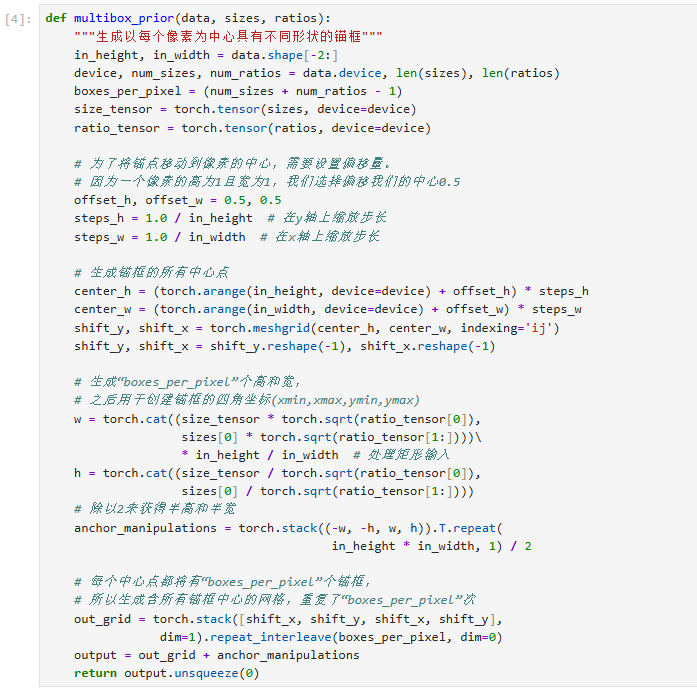
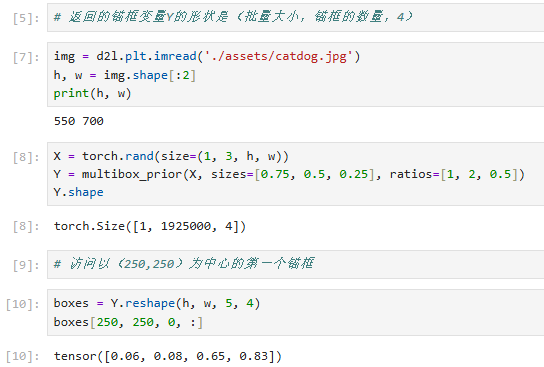
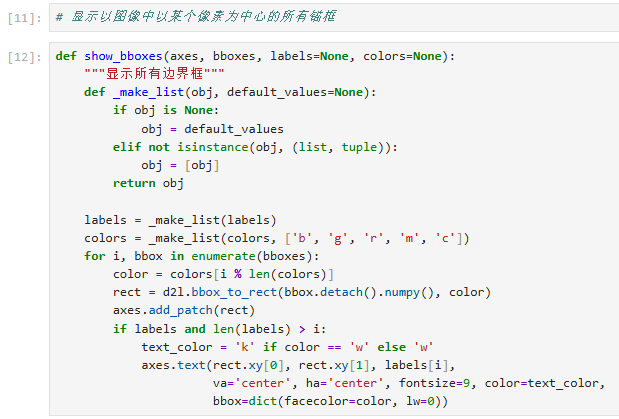
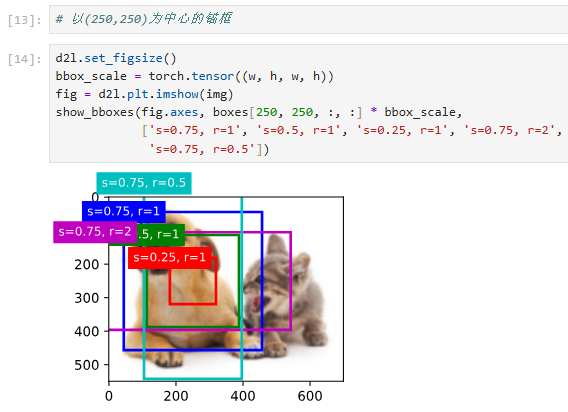
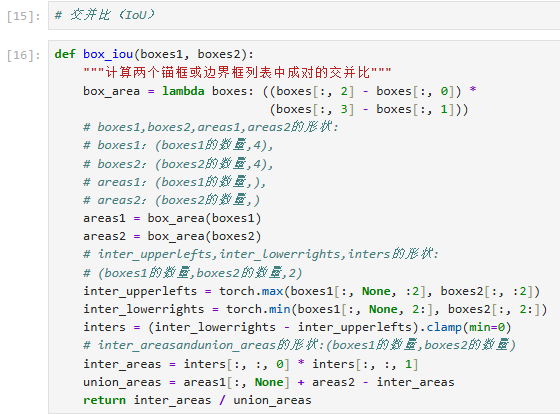
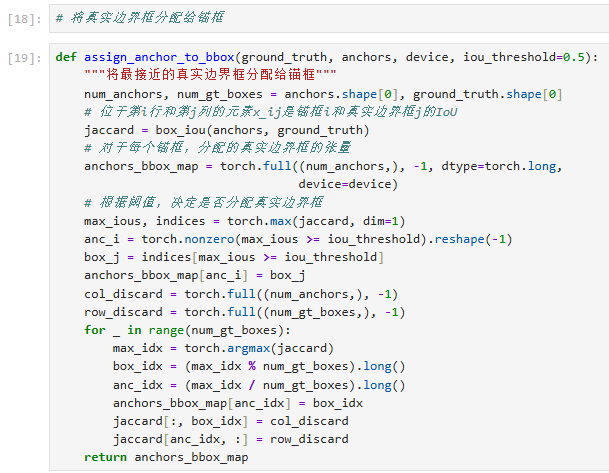

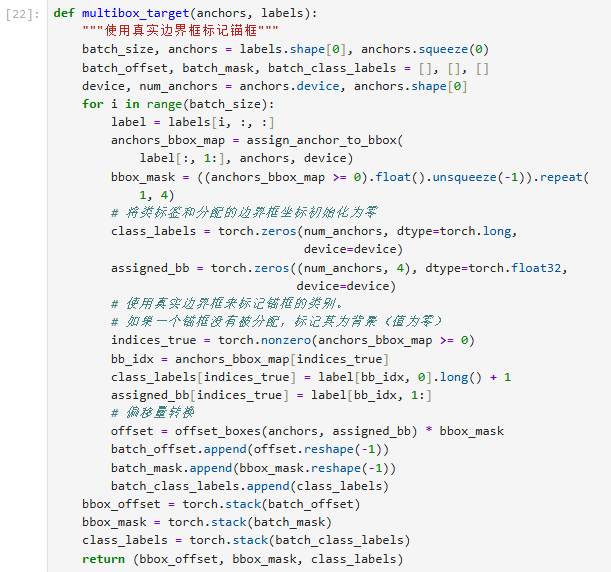
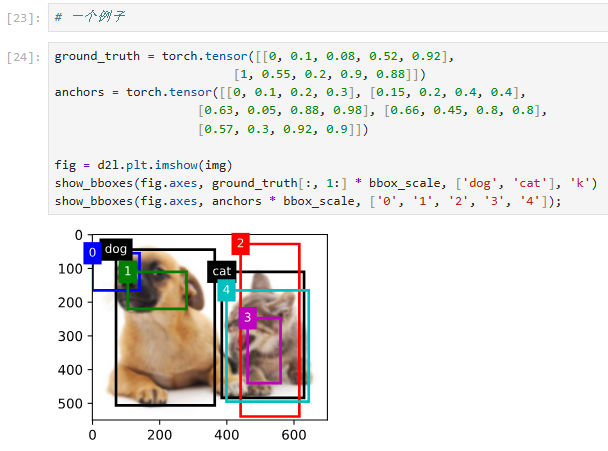
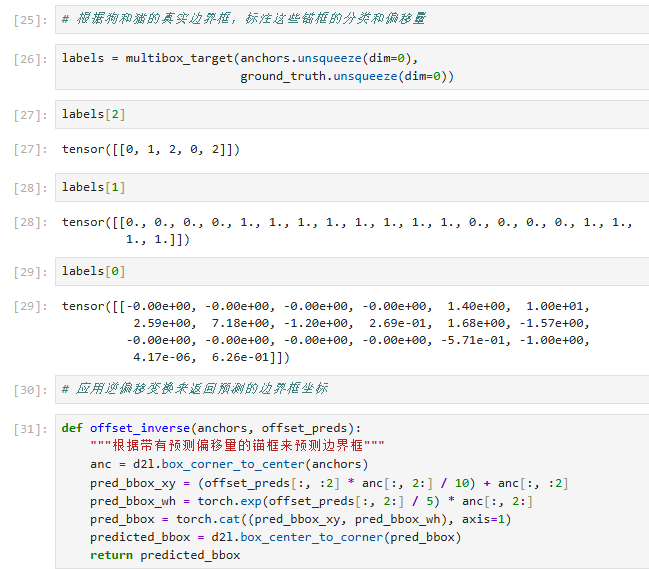
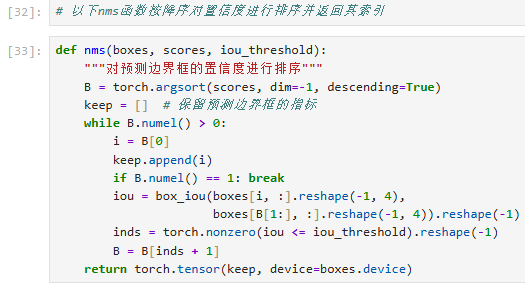
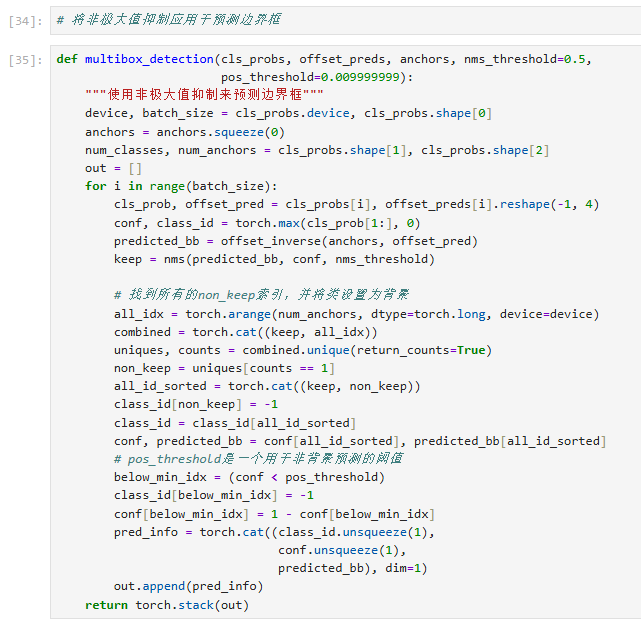
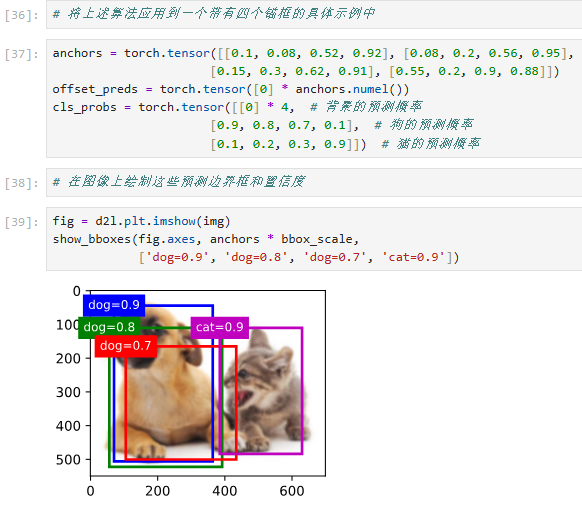
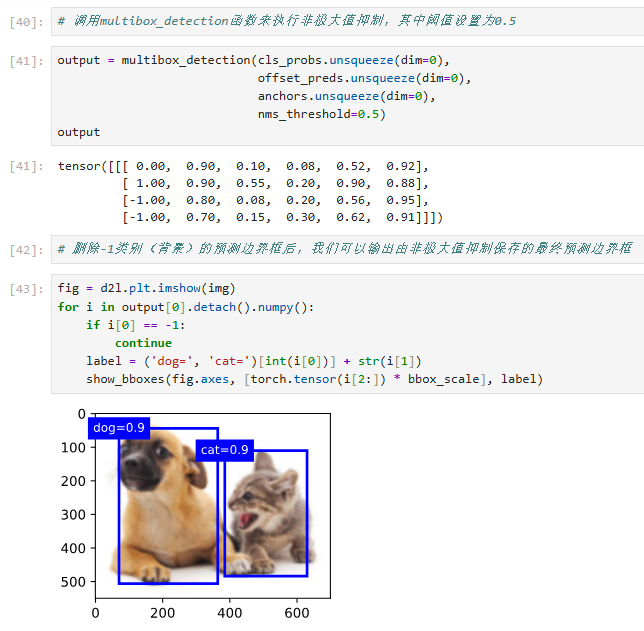
代码解释
从头到尾用"快递站管理系统"的比喻方式,完整解释每一行代码的功能和意义。
1. 导入库 - 准备工具包
import torch # 主工具箱:搬运工(张量操作)
from d21 import torch as d21 # 专用工具包:快递站定制工具(边界框转换等)
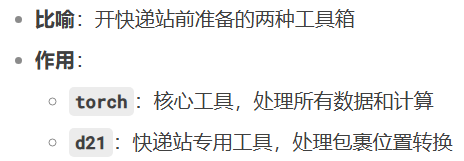
torch.set_printoptions(2) # 设置测量精度:小数点后2位

2. 锚框生成 - 布置仓库货架
def multisourceplot(data, sizes, ratios):
# 测量仓库尺寸
in_height, in_width = data.shape[-2:] # 获取仓库的长宽
# 准备工具
device = data.device # 确定使用哪种搬运车(CPU/GPU)
num_sizes, num_ratios = len(sizes), len(ratios) # 清点盒子类型
# 计算每个位置放几个盒子
boxes_per_pixel = (num_sizes + num_ratios - 1) # 每位置放4个盒子
# 准备盒子模板
size_tensor = torch.tensor(sizes, device=device) # 小/中/大三种盒子
ratio_tensor = torch.tensor(ratios, device=device) # 方形/长方形模板
# 确定每个格子的中心点
offset_h, offset_w = 0.5, 0.5 # 从格子角落往中心走0.5步
steps_h = 1.0 / in_height # 纵向每步距离
steps_w = 1.0 / in_width # 横向每步距离
# ️ 创建坐标网格
center_h = (torch.arange(in_height, device=device) + offset_h) * steps_h
center_w = (torch.arange(in_width, device=device) + offset_w) * steps_w
shift_y, shift_x = torch.meshgrid(center_h, center_w, indexing='ij')
shift_y, shift_x = shift_y.reshape(-1), shift_x.reshape(-1) # 压平网格
# 计算每种盒子的实际尺寸
# 第一类:固定形状,不同大小
w1 = size_tensor * torch.sqrt(ratio_tensor[0])
h1 = size_tensor / torch.sqrt(ratio_tensor[0])
# 第二类:固定大小,不同形状
w2 = sizes[0] * torch.sqrt(ratio_tensor[1:])
h2 = sizes[0] / torch.sqrt(ratio_tensor[1:])
# 合并所有盒子尺寸
w = torch.cat((w1, w2))
h = torch.cat((h1, h2))
# 组装盒子位置偏移量
anchor_manipulations = torch.stack((-w, -h, w, h)).T.repeat(
in_height * in_width, 1) / 2 # 计算每个盒子四角偏移
# ️ 为每个位置分配中心点
out_grid = torch.stack([shift_x, shift_y, shift_x, shift_y],
dim=1).repeat_interleave(boxes_per_pixel, dim=0)
# 最终确定每个盒子位置
output = out_grid + anchor_manipulations # 中心点 + 偏移量
return output.unsqueeze(0) # 返回货架布置图(添加批次维度)
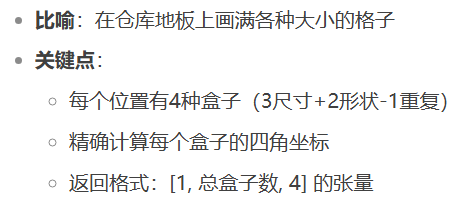
3. IoU计算 - 测量格子重叠率
def box_iou(boxes1, boxes2):
# 定义量具:计算格子面积
box_area = lambda boxes: ((boxes[:, 2] - boxes[:, 0]) *
(boxes[:, 3] - boxes[:, 1]))
# 测量两组格子各自面积
areas1 = box_area(boxes1) # 第一组格子面积
areas2 = box_area(boxes2) # 第二组格子面积
# 计算重叠区域
# 左上角取较大值(更靠右下的左上角)
inter_upperlefts = torch.max(boxes1[:, None, :2], boxes2[:, :2])
# 右下角取较小值(更靠左上的右下角)
inter_lowerrights = torch.min(boxes1[:, None, 2:], boxes2[:, 2:])
# 计算重叠区域尺寸(负数取0)
inters = (inter_lowerrights - inter_upperlefts).clamp(min=0)
# 计算重叠面积
inter_areas = inters[:, :, 0] * inters[:, :, 1]
# 计算总面积
union_areas = areas1[:, None] + areas2 - inter_areas
# 返回重叠比例
return inter_areas / union_areas

4. 锚框分配 - 给包裹分配存储格
def assign_anchor_to_bbox(ground_truth, anchors, device, iou_threshold=0.5):
# 清点资源
num_anchors = anchors.shape[0] # 空盒子数量
num_gt = ground_truth.shape[0] # 包裹数量
# 测量每个空盒与包裹的匹配度
jaccard = box_iou(anchors, ground_truth) # 计算IoU矩阵
# ️ 初始化分配表(-1表示未分配)
anchor_bbox_map = torch.full((num_anchors,), -1, dtype=torch.long, device=device)
# 第一轮分配:高匹配度直接分配
max_iou, indices = torch.max(jaccard, dim=1) # 每个盒子找最佳匹配
anc_i = torch.nonzero(max_iou >= iou_threshold).reshape(-1) # 找出匹配度高的盒子
box_j = indices[anc_i] # 对应的包裹编号
anchor_bbox_map[anc_i] = box_j # 登记分配关系
# 第二轮分配:确保每个包裹都有盒子
col_discard = torch.full((num_anchors,), -1) # 列作废标记
row_discard = torch.full((num_gt,), -1) # 行作废标记
for _ in range(num_gt): # 遍历每个包裹
max_idx = torch.argmax(jaccard) # 找全局最佳匹配
box_idx = (max_idx % num_gt).long() # 包裹编号
anc_idx = (max_idx // num_gt).long() # 盒子编号
anchor_bbox_map[anc_idx] = box_idx # 分配盒子
# 标记已分配的包裹和盒子
jaccard[:, box_idx] = col_discard # 该包裹列作废
jaccard[anc_idx, :] = row_discard # 该盒子行作废
return anchor_bbox_map # 返回分配表
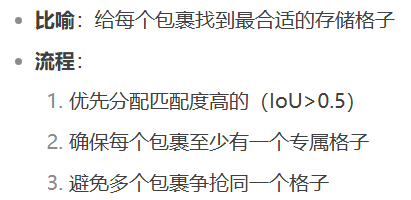
5. 偏移计算 - 记录格子调整量
def offset_boxes(anchors, assigned_bb, eps=1e-6):
# 转换坐标格式:从四角→中心+尺寸
c_anc = d21.box_corner_to_center(anchors) # 格子当前尺寸
c_assigned = d21.box_corner_to_center(assigned_bb) # 包裹实际尺寸
# 计算中心点偏移(带缩放因子)
offset_xy = 10 * (c_assigned[:, :2] - c_anc[:, :2]) / c_anc[:, 2:]
# 计算尺寸缩放量(对数形式更稳定)
offset_wh = 5 * torch.log(eps + c_assigned[:, 2:] / c_anc[:, 2:])
return torch.cat([offset_xy, offset_wh], axis=1) # 返回调整量表

6. 训练标签生成 - 创建员工培训手册
def multibox_target(anchors, labels):
# 初始化培训资料
batch_size = labels.shape[0] # 培训包裹批次大小
anchors = anchors.squeeze(0) # 移除批次维度
batch_offset, batch_mask, batch_class_labels = [], [], [] # 三个培训模块
# 处理每个培训包裹
for i in range(batch_size):
label = labels[i, :, :] # 当前包裹信息
# ️ 分配格子
anchor_bbox_map = assign_anchor_to_bbox(label[:, 1:], anchors, device)
# 创建格子使用标记
bbox_mask = ((anchor_bbox_map >= 0).float().unsqueeze(-1)).repeat(1, 4)
# ️ 初始化标签
class_labels = torch.zeros(anchors.shape[0], dtype=torch.long, device=device)
assigned_bb = torch.zeros((anchors.shape[0], 4), dtype=torch.float32, device=device)
# 标记有包裹的格子
indices_true = torch.nonzero(anchor_bbox_map >= 0).flatten()
bb_idx = anchor_bbox_map[indices_true]
class_labels[indices_true] = label[bb_idx, 0].long() + 1 # 类别+1(0留给空)
assigned_bb[indices_true] = label[bb_idx, 1:] # 记录包裹位置
# 计算格子调整量
offset = offset_boxes(anchors, assigned_bb) * bbox_mask
# 收集培训资料
batch_offset.append(offset.reshape(-1))
batch_mask.append(bbox_mask.reshape(-1))
batch_class_labels.append(class_labels)
# 打包培训手册
return (torch.stack(batch_offset),
torch.stack(batch_mask),
torch.stack(batch_class_labels))
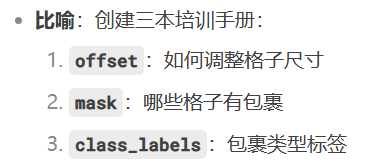
7. 预测解码 - 应用调整建议
def offset_inverse(anchors, offset_preds):
# 转换坐标格式
c_anc = d21.box_corner_to_center(anchors)
# 应用中心点调整
pred_bbox_xy = (offset_preds[:, :2] * c_anc[:, 2:] / 10 + c_anc[:, :2]
# 应用尺寸调整
pred_bbox_wh = torch.exp(offset_preds[:, 2:] / 5) * c_anc[:, 2:]
# 重组预测框
pred_bbox = torch.cat([pred_bbox_xy, pred_bbox_wh], axis=1)
# 转换回四角坐标
return d21.box_center_to_corner(pred_bbox)

8. NMS - 去重检查
def nms(boxes, scores, iou_threshold):
# 按可信度排序
B = torch.argsort(scores, dim=-1, descending=True)
keep = [] # 保留列表
# 遍历所有盒子
while B.numel() > 0:
i = B[0] # 当前最可信的盒子
keep.append(i) # 加入保留列表
if B.numel() == 1: # 只剩一个盒子时退出
break
# 计算与其他盒子的重叠率
iou = box_iou(boxes[i, :].reshape(-1, 4),
boxes[B[1:], :].reshape(-1, 4)).reshape(-1)
# 保留重叠率低的盒子
inds = torch.nonzero(iou <= iou_threshold).reshape(-1)
B = B[inds + 1] # 更新待处理列表
return torch.tensor(keep, device=boxes.device) # 返回保留盒子的索引
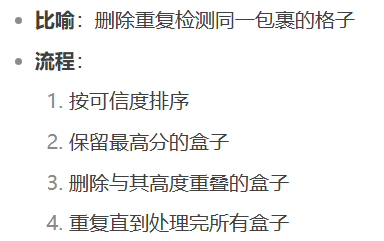
9. 检测后处理 - 生成最终报告
def multibox_detection(cls_probs, offset_preds, anchors, nms_threshold=0.5, pos_threshold=0.01):
# 准备报告模板
device = cls_probs.device
batch_size = cls_probs.shape[0]
anchors = anchors.squeeze(0)
out = [] # 最终报告列表
# 处理每个仓库区域
for i in range(batch_size):
# 获取员工扫描结果
cls_prob = cls_probs[i] # 每个格子的包裹概率
offset_pred = offset_preds[i].reshape(-1, 4) # 尺寸调整建议
# 找出可能含包裹的格子
conf, class_id = torch.max(cls_prob[1:], 0) # 跳过背景类别
# 应用尺寸调整
predicted_bb = offset_inverse(anchors, offset_pred)
# 去重处理
keep = nms(predicted_bb, conf, nms_threshold)
# 重组所有格子信息
all_idx = torch.arange(anchors.shape[0], dtype=torch.long, device=device)
combined = torch.cat([keep, all_idx])
uniques, counts = combined.unique(return_counts=True)
non_keep = uniques[counts == 1] # 找出NMS未保留的格子
# ️ 标记空格子
class_id[non_keep] = -1 # -1表示空格子
# 排序格子信息
all_id_sorted = torch.cat([keep, non_keep])
conf = conf[all_id_sorted]
predicted_bb = predicted_bb[all_id_sorted]
# 过滤低可信度格子
below_min_idx = (conf < pos_threshold)
class_id[below_min_idx] = -1 # 标记为空
conf[below_min_idx] = 1 - conf[below_min_idx] # 计算背景概率
# 生成区域报告
pred_info = torch.cat((class_id.unsqueeze(1),
conf.unsqueeze(1),
predicted_bb), dim=1)
out.append(pred_info)
return torch.stack(out) # 返回最终报告
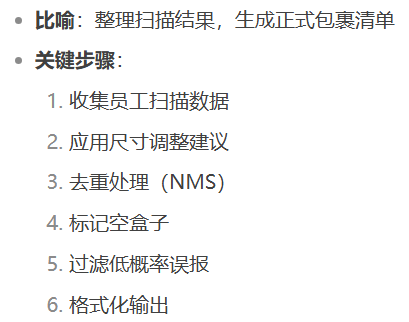
全流程总结
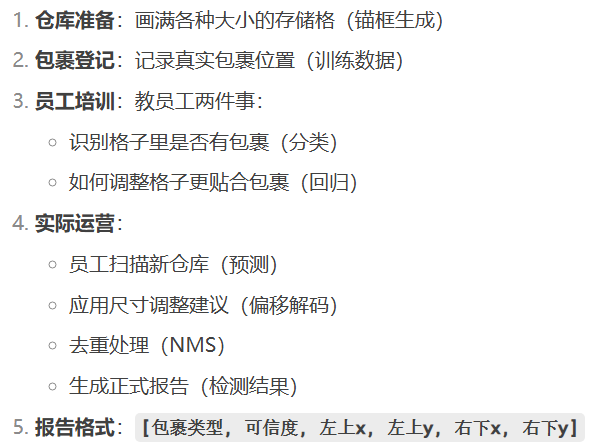
锚框 anchor box的更多相关文章
- 『计算机视觉』Mask-RCNN_锚框生成
Github地址:Mask_RCNN 『计算机视觉』Mask-RCNN_论文学习 『计算机视觉』Mask-RCNN_项目文档翻译 『计算机视觉』Mask-RCNN_推断网络其一:总览 『计算机视觉』M ...
- 『计算机视觉』Mask-RCNN_推断网络其三:RPN锚框处理和Proposal生成
一.RPN锚框信息生成 上文的最后,我们生成了用于计算锚框信息的特征(源代码在inference模式中不进行锚框生成,而是外部生成好feed进网络,training模式下在向前传播时直接生成锚框,不过 ...
- anchor box聚类
fast rcnn和rfcn中使用的都是默认的anchor box设置,都是9种,比例为0.5 .1. 2,大小为128.256.512.但我的数据集的gt框更小,需要找到适合我的数据集的anchor ...
- CSS 框模型( Box module )
框和布局 在 KB005: CSS 层叠 中已经介绍了 CSS 的重要之处.CSS 可以说是页面表现的基础, CSS 可以控制布局,控制元素的渲染. 布局是讲在电影画面构图中,对环境的布置.人物地位的 ...
- KB006: CSS 框模型( Box module )
框和布局 在 KB005: CSS 层叠 中已经介绍了 CSS 的重要之处.CSS 可以说是页面表现的基础, CSS 可以控制布局,控制元素的渲染. 布局是讲在电影画面构图中,对环境的布置.人物地位的 ...
- 列表框List Box
List Box/Check List Box ListBox窗口用来列出一系列的文本,每条文本占一行.创建一个列表窗口可以使用成员函数: BOOL CListBox::Create( LPCTSTR ...
- 『TensorFlow』SSD源码学习_其三:锚框生成
Fork版本项目地址:SSD 上一节中我们定义了vgg_300的网络结构,实际使用中还需要匹配SSD另一关键组件:被选取特征层的搜索网格.在项目中,vgg_300网络和网格生成都被统一进一个class ...
- MFC 下拉框Combo Box
下拉框常用的事件是Change事件.属性常用:Data(英文;分隔),Sort(是否排序) // OnInitDialog()中 m_cbx.SetCurSel();//设置默认选项 //OnBnCl ...
- [04-05]box框模型(Box Model)定义了元素框处理元素内容、内边距、边框和外边距的方式
实际占有的宽 = width + 2padding(内边距) + 2border(边框) + 2margin(外边距) 实际占有的高 = height + 2padding + 2border + 2 ...
- Javascript 实现锚点(Anchor)间平滑跳转
(function($){ $.fn.scroller = function(options){ var defaultVal = { duration: }; var obj = $.extend( ...
随机推荐
- JuiceFS v1.3-beta1:新增 Python SDK,特定场景性能 3 倍于 FUSE
在当前众多 AI 和数据科学应用中,Python 已成为最主流的编程语言之一.为了方便用户在这些场景中更高效地使用 JuiceFS,我们在社区版 v1.3 中推出了 JuiceFS Python SD ...
- 操作系统:详解socket的接口实现
上节了解了套接字的工作机制和数据结构,但套接字有哪些基本接口实现呢? 套接字接口 套接字接口最初是 BSD 操作系统的一部分,在应用层与 TCP/IP 协议栈之间接供了一套标准的独立于协议的接口. L ...
- 网络编程:UDP connect连接
UDP connect的作用 UDP connect函数的调用,并不会引起像TCP连接那样,和服务器目标端网络交互,并不会触发所谓的"握手"报文发送和应答. UDP套接字进行con ...
- Grind75详解
Day1 001 ToSum //O(n2) public int[] TwoSum(int[] nums, int target) { for (int i = 0; i < nums.Len ...
- JQuery元素滚动定位及获取元素的scrollTop,clientHeight,scrollHeight
scrollHeight为滚动DIV的实际总体高度,获取方式为:$(obj)[0].scrollHeight clientHeight为滚动DIV的可见高度,获取方式为:$(obj)[0].clien ...
- Java进阶知识点:接口幂等性
幂等概念 在计算机中,表示对同一个过程应用相同的参数多次和应用一次产生的效果是一样,这样的过程即被称为满足幂等性. 也可以进行如下表述:一个HTTP请求方法,如果被请求多次和被请求一次效果 ...
- chrome和firefox driver使用代理
chrome chromedriver使用代理示例 from selenium import webdriver from selenium.webdriver import DesiredCapab ...
- 深入理解Nginx-模块开发与架构解析(第2版)第一章
为什么选择Nginx 更快 高扩展性 高可靠性 低内存消耗 单机支持10万以上的并发连接 热部署 最自由的BSD许可协议 Nginx先天的事件驱动型设计.全异步的网络I/O处理机制.极少的进程间切换以 ...
- Svelte 5状态管理实战:基于Tauri框架的AI阅读器Saga Reader开发实践
一.项目背景:当AI阅读遇到跨平台需求 Saga Reader(麒睿智库)是一款基于AI技术的轻量级跨平台阅读器,核心功能涵盖RSS订阅.内容智能抓取.AI内容处理(如翻译.摘要)及本地存储.项目采用 ...
- Office 2024 专业增强版超详细下载安装教程(附安装包)
目录 一.Office 2024 专业增强版软件简介 二.Office 2024 专业增强版安装准备 三.Office 2024 专业增强版安装步骤 下载Office 2024安装包: 运行Offic ...
